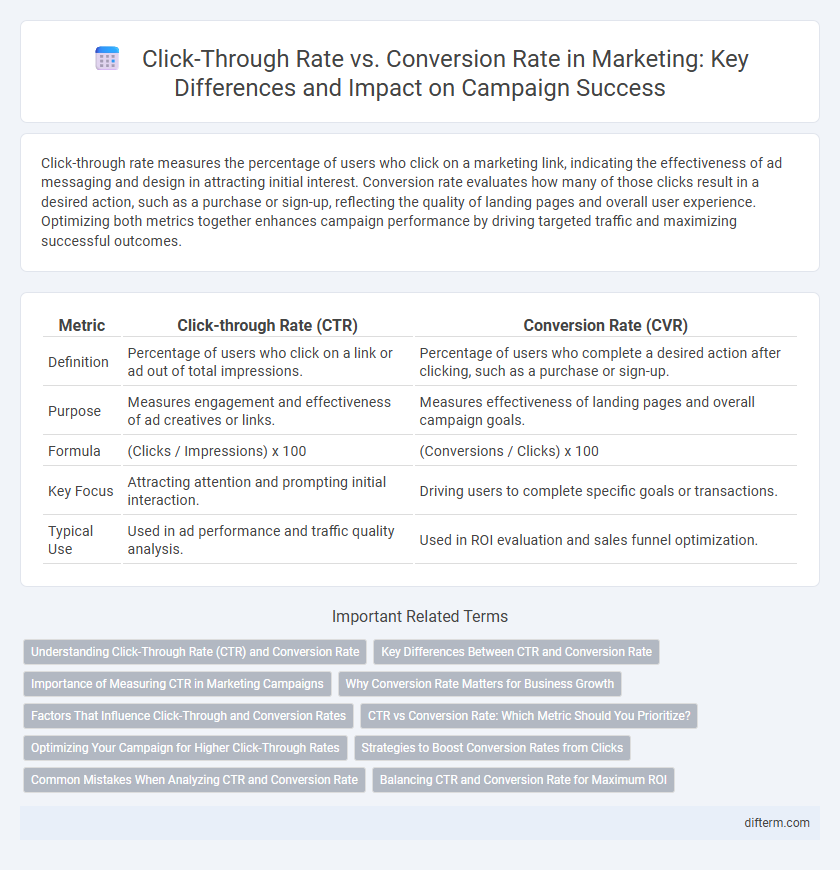Click-through rate measures the percentage of users who click on a marketing link, indicating the effectiveness of ad messaging and design in attracting initial interest. Conversion rate evaluates how many of those clicks result in a desired action, such as a purchase or sign-up, reflecting the quality of landing pages and overall user experience. Optimizing both metrics together enhances campaign performance by driving targeted traffic and maximizing successful outcomes.
Table of Comparison
| Metric | Click-through Rate (CTR) | Conversion Rate (CVR) |
|---|---|---|
| Definition | Percentage of users who click on a link or ad out of total impressions. | Percentage of users who complete a desired action after clicking, such as a purchase or sign-up. |
| Purpose | Measures engagement and effectiveness of ad creatives or links. | Measures effectiveness of landing pages and overall campaign goals. |
| Formula | (Clicks / Impressions) x 100 | (Conversions / Clicks) x 100 |
| Key Focus | Attracting attention and prompting initial interaction. | Driving users to complete specific goals or transactions. |
| Typical Use | Used in ad performance and traffic quality analysis. | Used in ROI evaluation and sales funnel optimization. |
Understanding Click-Through Rate (CTR) and Conversion Rate
Click-through rate (CTR) measures the percentage of users who click on a specific link or ad out of the total viewers, indicating the effectiveness of the advertisement's appeal and targeting. Conversion rate tracks the proportion of users who complete a desired action, such as making a purchase or signing up, after clicking through, reflecting the success of the landing page and overall sales funnel. Analyzing both metrics provides critical insights into user engagement and the efficiency of marketing campaigns, enabling data-driven optimization strategies.
Key Differences Between CTR and Conversion Rate
Click-through rate (CTR) measures the percentage of users who click on an ad or link out of the total viewers, reflecting initial engagement. Conversion rate, on the other hand, tracks the percentage of users who complete a desired action, such as making a purchase or signing up, after clicking through. CTR indicates the effectiveness of ad relevance and appeal, while conversion rate reveals the success of the landing page and overall campaign in driving user actions.
Importance of Measuring CTR in Marketing Campaigns
Measuring click-through rate (CTR) in marketing campaigns provides vital insights into the effectiveness of ad creatives and audience targeting by showing how many users engage with the content. High CTR indicates strong ad relevance and can lead to improved quality scores on platforms like Google Ads, reducing overall campaign costs. Tracking CTR allows marketers to optimize their strategies continuously, maximizing engagement before focusing on conversion rate metrics.
Why Conversion Rate Matters for Business Growth
Conversion rate directly impacts revenue by measuring the percentage of visitors who complete desired actions, such as purchases or sign-ups, making it a crucial indicator of marketing effectiveness. While click-through rate (CTR) shows how well an ad captures attention, conversion rate reveals the true value of traffic by turning interest into measurable business outcomes. Optimizing conversion rate drives sustainable growth by increasing customer acquisition and maximizing return on marketing investment.
Factors That Influence Click-Through and Conversion Rates
Click-through rate (CTR) is primarily influenced by ad relevance, compelling headlines, and targeted audience segmentation, which drive users to engage with the content. Conversion rate depends on factors like landing page design, clear call-to-action, and user experience that facilitate the completion of desired actions. Both metrics are affected by personalization, device type, and load speed, making optimization crucial for effective marketing campaigns.
CTR vs Conversion Rate: Which Metric Should You Prioritize?
Click-through rate (CTR) measures the percentage of users who click on your ad or link, indicating initial interest, while conversion rate tracks the percentage of those clicks that result in a desired action like a purchase or signup. Prioritizing CTR helps optimize ad engagement and drive traffic, whereas focusing on conversion rate ensures that the traffic generated leads to meaningful business outcomes. Marketers should align metric priorities with campaign goals, emphasizing CTR for awareness and conversion rate for return on investment (ROI).
Optimizing Your Campaign for Higher Click-Through Rates
Optimizing your campaign for higher click-through rates (CTR) involves creating compelling ad copy, targeting the right audience segments, and using eye-catching visuals to increase engagement. Higher CTR indicates effective ad relevance, which improves quality scores and reduces cost-per-click, driving more traffic to your landing pages. Monitoring CTR alongside conversion rate helps identify whether increased clicks translate into actual sales or leads, allowing for precise adjustments in campaign strategy.
Strategies to Boost Conversion Rates from Clicks
Implement targeted landing pages that align closely with ad content to enhance user experience and increase conversion rates from clicks. Utilize A/B testing to optimize call-to-action buttons, headlines, and page layouts for higher engagement and reduced bounce rates. Incorporate clear value propositions and social proof to build trust and encourage immediate action, driving more conversions from existing click-through traffic.
Common Mistakes When Analyzing CTR and Conversion Rate
Misinterpreting click-through rate (CTR) as a direct indicator of conversion success can lead to flawed marketing strategies since high CTR does not always correlate with high conversion rate. Ignoring the quality of traffic and user intent behind clicks often results in overestimating campaign effectiveness and misallocating budget. Proper segmentation and attribution analysis are critical to accurately assess the impact of CTR and conversion rate on overall marketing performance.
Balancing CTR and Conversion Rate for Maximum ROI
Maximizing ROI in marketing requires a strategic balance between click-through rate (CTR) and conversion rate, as high CTR drives traffic while high conversion rate ensures that traffic results in sales or desired actions. An optimized campaign targets an ideal combination where attracting quality leads through compelling ads aligns with a seamless user experience that encourages conversions. Leveraging data analytics to continuously monitor and adjust both CTR and conversion rates enhances budget efficiency and overall campaign effectiveness.
Click-through rate vs conversion rate Infographic

 difterm.com
difterm.com